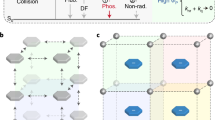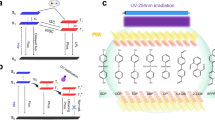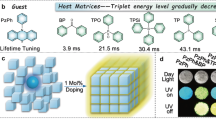Abstract
Materials exhibiting long-lived, persistent luminescence in the visible spectrum are useful for applications in the display, information encryption and bioimaging sectors1,2,3,4. Herein, we report the development of several organic phosphors that provide colour-tunable, ultra-long organic phosphorescence (UOP). The emission colour can be tuned by varying the excitation wavelength, allowing dynamic colour tuning from the violet to the green part of the visible spectrum. Our experimental data reveal that these organic phosphors can have an ultra-long lifetime of 2.45 s and a maximum phosphorescence efficiency of 31.2%. Furthermore, we demonstrate the applications of colour-tunable UOP for use in a multicolour display and visual sensing of ultraviolet light in the range from 300 to 360 nm. The findings open the opportunity for the development of smart luminescent materials and sensors with dynamically controlled phosphorescence.
This is a preview of subscription content, access via your institution
Access options
Access Nature and 54 other Nature Portfolio journals
Get Nature+, our best-value online-access subscription
$29.99 / 30 days
cancel any time
Subscribe to this journal
Receive 12 print issues and online access
$209.00 per year
only $17.42 per issue
Buy this article
- Purchase on Springer Link
- Instant access to full article PDF
Prices may be subject to local taxes which are calculated during checkout





Similar content being viewed by others
Data availability
The data that support the plots within this paper and other findings of this study are available from the corresponding author upon reasonable request.
References
Pan, Z., Lu, Y. & Liu, F. Sunlight-activated long-persistent luminescence in the near-infrared from Cr3+-doped zinc gallogermanates. Nat. Mater. 11, 58–63 (2012).
Maldiney, T. et al. The in vivo activation of persistent nanophosphors for optical imaging of vascularization, tumours and grafted cells. Nat. Mater. 13, 418–426 (2014).
Xu, S., Chen, R., Zheng, C. & Huang, W. Excited state modulation for organic afterglow: materials and applications. Adv. Mater. 28, 9920–9940 (2016).
Su, Y. et al. Ultralong room temperature phosphorescence from amorphous organic materials toward confidential information encryption and decryption. Sci. Adv. 4, 9732–9743 (2018).
Lee, J. et al. Universal process-inert encoding architecture for polymer microparticles. Nat. Mater. 13, 524–529 (2014).
Lee, H., Kim, J., Kim, H., Kim, J. & Kwon, S. Colour-barcoded magnetic microparticles for multiplexed bioassays. Nat. Mater. 9, 745–749 (2010).
Deng, R. et al. Temporal full-colour tuning through non-steady-state upconversion. Nat. Nanotechnol. 10, 237–242 (2015).
Pan, L. et al. Truly fluorescent excitation-dependent carbon dots and their applications in multicolor cellular imaging and multidimensional sensing. Adv. Mater. 27, 7782–7787 (2015).
Farinola, G. M. & Ragni, R. Electroluminescent materials for white organic light emitting diodes. Chem. Soc. Rev. 40, 3467–3482 (2011).
Irie, M., Fukaminato, T., Matsuda, K. & Kobatake, E. Photochromism of diarylethene molecules and crystals: memories, switches, and actuators. Chem. Rev. 114, 12174–12277 (2014).
Mao, Z. et al. Linearly tunable emission colors obtained from a fluorescent–phosphorescent dual-emission compound by mechanical stimuli. Angew. Chem. Int. Ed. 54, 6270–6273 (2015).
Sun, Y. et al. Quantum-sized carbon dots for bright and colorful photoluminescence. J. Am. Chem. Soc. 128, 7756–7757 (2006).
Chen, O. et al. Excitation-intensity-dependent color-tunable dual emissions from manganese-doped CdS/ZnS core/shell nanocrystals. Angew. Chem. Int. Ed. 49, 10132–10135 (2010).
Lee, K. et al. Excitation-dependent visible fluorescence in decameric nanoparticles with monoacylglycerol cluster chromophores. Nat. Commun. 4, 1544–1551 (2013).
Xu, J. & Tanabe, S. Persistent luminescence instead of phosphorescence: History, mechanism, and perspective. J. Lumin. 205, 581–620 (2019).
Bolton, O., Lee, K., Kim, H., Lin, K. Y. & Kim, J. Activating efficient phosphorescence from purely organic materials by crystal design. Nat. Chem. 3, 205–210 (2011).
Zhang, G. et al. Multi-emissive difluoroboron dibenzoylmethane polylactide exhibiting intense fluorescence and oxygen-sensitive room-temperature phosphorescence. J. Am. Chem. Soc. 129, 8942–8943 (2007).
Yang, Z. et al. Intermolecular electronic coupling of organic units for efficient persistent room-temperature phosphorescence. Angew. Chem. Int. Ed. 55, 2181–2185 (2016).
He, Z. et al. White light emission from a single organic molecule with dual phosphorescence at room temperature. Nat. Commun. 8, 416 (2017).
Xie, Y. et al. How the molecular packing affects the room temperature phosphorescence in pure organic compounds: ingenious molecular design, detailed crystal analysis, and rational theoretical calculations. Adv. Mater. 29, 1606829–1606836 (2017).
Shoji, Y. et al. Unveiling a new aspect of simple arylboronic esters: long-lived room-temperature phosphorescence from heavy-atom-free molecules. J. Am. Chem. Soc. 139, 2728–2733 (2017).
Wei, J. et al. Induction of strong long-lived room-temperature phosphorescence of N-phenyl-2-naphthylamine molecules by confinement in a crystalline dibromobiphenyl matrix. Angew. Chem. Int. Ed. 55, 15589–15593 (2016).
Hirata, S. et al. Efficient persistent room temperature phosphorescence in organic amorphous materials under ambient conditions. Adv. Funct. Mater. 23, 3386–3397 (2013).
Yang, X. & Yan, D. Strongly enhanced long-lived persistent room temperature phosphorescence based on the formation of metal–organic hybrids. Adv. Opt. Mater. 4, 897–905 (2016).
An, Z. et al. Stabilizing triplet excited states for ultralong organic phosphorescence. Nat. Mater. 14, 685–690 (2015).
Lucenti, E. et al. Cyclic triimidazole derivatives: intriguing examples of multiple emissions and ultralong phosphorescence at room temperature. Angew. Chem. Int. Ed. 56, 16302–16307 (2017).
Ma, X., Xu, C., Wang, J. & Tian, H. Heavy-atom-free amorphous pure organic polymers with efficient room-temperature phosphorescence emission. Angew. Chem. Int. Ed. 130, 11020–11024 (2018).
Li, Q. et al. Induction of long-lived room temperature phosphorescence of carbon dots by water in hydrogen-bonded matrices. Nat. Commun. 9, 734 (2018).
Dou, X. et al. Clustering-triggered emission and persistent room temperature phosphorescence of sodium alginate. Biomacromolecules 19, 2014–2022 (2018).
Ogoshi, T. et al. Ultralong room-temperature phosphorescence from amorphous polymer poly(styrene sulfonic acid) in air in the dry solid state. Adv. Funct. Mater. 28, 1707369–1707376 (2018).
Tao, S. et al. Design of metal-free polymer carbon dots: a new class of room temperature phosphorescent materials. Angew. Chem. Int. Ed. 57, 2393–2398 (2018).
Kim, T. et al. Full-colour quantum dot displays fabricated by transfer printing. Nat. Photon. 5, 176–182 (2011).
Baryshnikov, G., Minaev, B. & Ågren, H. Theory and calculation of the phosphorescence phenomenon. Chem. Rev. 117, 6500–6537 (2017).
Acknowledgements
This work is supported by the National Natural Science Foundation of China (21875104, 51673095, 91833304, 91833302 and 61605074), National Basic Research Program of China (973 Program, No. 2015CB932200), Natural Science Fund for Distinguished Young Scholars of Jiangsu Province (BK20180037), the Natural Science Fund for Colleges and Universities (17KJB430020) of Jiangsu Province, and Nanjing Tech Start-up Grant (3983500158 and 3983500169). We are grateful to the High Performance Computing Center of Nanjing Tech University for technical support.
Author information
Authors and Affiliations
Contributions
L.G., H.S., Z.A., X.L. and W.H. conceived the experiments. H.S., Z.A., X.L. and W.H. wrote the manuscript. L.G., H.S., L.B., M.G., S.W., Y.G., W.Y. and F.H. were primarily responsible for the experiments. K.L. and L.F. measured the quantum efficiency. X.W., S.W. and H.W. performed the lifetime measurements. S.C., W.N. and Y.T. conducted the single-crystal measurement and analysis. H.M. contributed to TD-DFT calculations. All authors contributed to the data analyses.
Corresponding authors
Ethics declarations
Competing interests
The authors declare no competing interests.
Additional information
Publisher’s note: Springer Nature remains neutral with regard to jurisdictional claims in published maps and institutional affiliations.
Supplementary information
Supplementary Information
Additional photophysical properties and theoretical calculations.
Supplementary Video 1
Demonstration of colour switching of the emission from the TMOT compound.
Supplementary Video 2
Visible blue phosphorescence from the TMOT compound.
Rights and permissions
About this article
Cite this article
Gu, L., Shi, H., Bian, L. et al. Colour-tunable ultra-long organic phosphorescence of a single-component molecular crystal. Nat. Photonics 13, 406–411 (2019). https://doi.org/10.1038/s41566-019-0408-4
Received:
Accepted:
Published:
Issue Date:
DOI: https://doi.org/10.1038/s41566-019-0408-4
This article is cited by
-
Rapid room-temperature phosphorescence chiral recognition of natural amino acids
Nature Communications (2024)
-
Tunable afterglow for mechanical self-monitoring 3D printing structures
Nature Communications (2024)
-
Nucleic-acid-base photofunctional cocrystal for information security and antimicrobial applications
Nature Communications (2024)
-
Abnormal thermally-stimulated dynamic organic phosphorescence
Nature Communications (2024)
-
Pyrene-based cocrystals for regulation of extensive emission across visible to near-infrared II range
Science China Materials (2024)



